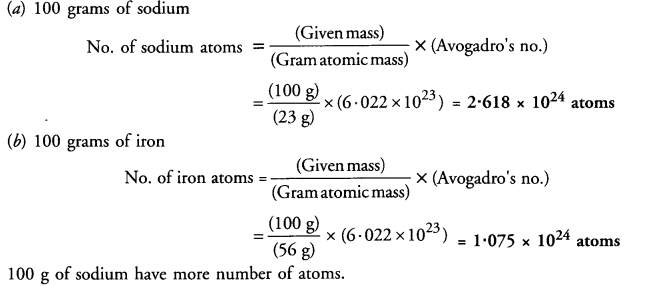GetStudySolution
Getstudysolution is an online educational platform that allows students to access quality educational services and study materials at no cost.
NCERT Solutions for Class 9 Science chapter 3 – Atoms and Molecules
Back Exercise
Question 1.
0.24 g of sample of a compound of oxygen and boron was found by analysis to contain 0.096 g of boron
and 0.144 g of oxygen. Calculate the percentage composition of the compound by weight.
Answer:

Question 2.
When 3.0 g of carbon is burnt in 8.0 g of oxygen, 11.0 g of carbon dioxide is formed. What mass of carbon dioxide will be formed when 3.0 g of carbon is burnt in 50.0 g of oxygen ? Which law of chemical combination will govern your answer ? (CBSE 2011, 2012)
Answer:
Carbon and oxygen react to form carbon dioxide according to the equation Carbon (C) + Oxygen (O2) > Carbon dioxide (CO2)

In the first case :
3.0 g of carbon are burnt in 8.0 g of oxygen to form 11.0 g of CO2 In the second case :
3.0 g of carbon must also combine with 8.0 g of oxygen only. This means that (50 – 8) = 42 g of oxygen will remain unreacted.
The mass of CO2 in this case must be also 11 g.
The answer is based on Law of constant proportions.
In the second case, only 8.0 g of oxygen react although 50.0 g are available. This shows that the mass of carbon dioxide (11.0 g) formed depends upon the mass of carbon (3.0 g) or the substance present in smaller amount. In general, the substance (element or compound) present in smaller amount in a reaction limits the participation of the other reactants. It is quite often called limiting reactant. Carbon is the limiting reactant in this case. It limits the participation of oxygen and also the formation of carbon dioxide.
Question 3.
What are polyatomic ions ? Give examples. (CBSE 2015)
Answer:
Polyatomic ions are the group of atoms which carry either positive charge (cations) or negative charge (anions). For example,
- Carbonate ion (CO3)2-
- Nitrate ion (NO3)–
- Ammonium ion (NH4)+
- Phosphate ion (PO4)3-.
Question 4.
Write the chemical formulae of the following :
Answer:
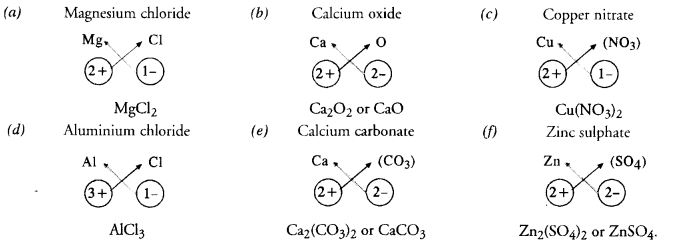
Question 5.
Give the names of the elements present in the following compounds :
(a) Quick lime
(b) Hydrogen bromide
(c) Baking powder
(d) Potassium sulphate.
Answer:
The names of elements present can be given only if the chemical formula of the compound is known. For example,
(a) Quick lime : It is the commercial name of the compound. Its chemical name is calcium oxide and the
chemical formula is CaO.
Elements present : calcium (Ca) : oxygen (O).
(b) Hydrogen bromide : The chemical formula of the compound is HBr
Elements present : hydrogen (H) ; bromine (Br).
(c) Baking powder : It is the commercial name of the compound. Its chemical name is sodium hydrogen carbonate and the chemical formula is NaHCO3
Elements present : sodium (Na), hydrogen (H), carbon (C), oxygen (O).
(d) Potassium sulphate : The chemical formula of the compound is K2SO4
Elements present : potassium (K), sulphur (S), oxygen (O).
Question 6.
Calculate the molar mass of the following substances :
(a) Ethyne, C2H2
(b) Sulphur molecule, S8
(c) Phosphorus molecule, P4 (Atomic mass of phosphorus = 31)
(d) Nitric acid, HNO3
(e) Hydrochloric acid, HCl.
Answer:
(a) Ethyne, C2H2
Molar mass of C2H2 = (2 x Atomic mass of C) + (2 x Atomic mass of H)
= (2 x 12 u) + (2 x 1 u) = 26 u.
(b) Sulphur molecule, S8
Molar mass of S8 = 8 x Atomic mass of S = (8 x 32 u) = 256 u
(c) Phosphorus molecule, P4
Molar mass of P4 =4 x Atomic mass of P = (4 x 31 u) = 124 u
(d) Nitric acid, HNO3
Molar mass of HNO3 = (1 x Atomic mass of H) + (1 x Atomic mass of N) + ( 3 x Atomic mass of O)
= (1 x 1 u) + (1 x 14 u) + (3 x 16 u) = 63 u.
(e) Hydrochloric acid, HCl.
Molar mass of HCl = (1 x Atomic mass of H) + (1 x Atomic mass of Cl)
= (1 x 1 u) + (1 x 35.5 u) = 36.5 u.
Question 7.
What is the mass of :
(a) 1 mole of nitrogen atoms ?
(b) 4 moles of aluminium atoms (Atomic mass of aluminium = 27) ?
(c) 10 moles of sodium sulphite (Na2SO3) ?
Answer:
(a) 1 mole of nitrogen atoms
Mass of 1 mole of nitrogen (N) atoms = 14 u
(b) 4 moles of aluminium atoms
Mass of 1 mole of aluminium (Al) atoms = 27 u
Mass of 4 moles of aluminium (Al) atoms = 4 x 27 = 108 u
(c) 10 moles of sodium sulphite (Na2SO3)
Molar mass of Na2SO3 = 2 x Atomic mass of Na + Atomic mass of S + 3 x Atomic mass of O
= 2 x 23 + 32 + 3 x 16 = 126 u
1 mole of sodium sulphite has mass = 126 u
10 moles of sodium sulphite have mass = 10 x 126 = 1260 u.
Question 8.
Convert into moles
(a) 12 g of oxygen gas
(b) 20 g of water
(c) 22 g of carbon dioxide.
Answer:
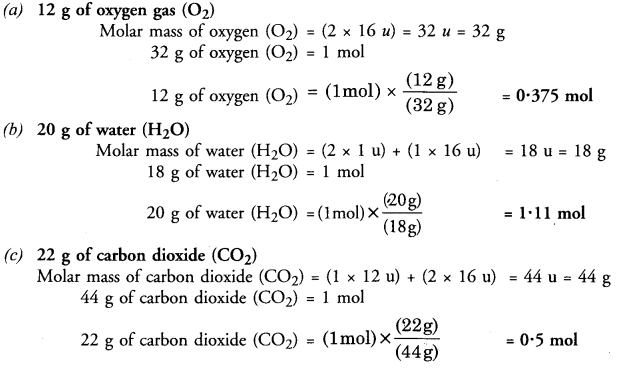
Question 9.
What is the mass of :
(a) 0.2 mole of oxygen atoms ?
(b) 0.5 mole of water molecules ?
Answer:
(a) 0.2 mole of oxygen atoms
Mass of 1 mole of oxygen (O) atoms = 16 u
Mass of 0.2 mole of oxygen (O) atoms = 0.2 x 16 = 3.2 u
(b) 0.5 mole of water molecules
Mass of 1 mole of water (H2O) molecules = 2 x 1 + 16 = 18 u
Mass of 0.5 mole of water (H2O) molecules = 0.5 x 18 = 9 u.
Question 10.
Calculate the number of molecules of sulphur (Sg) present in 16 g of solid sulphur.
Answer:

Question 11.
Calculate the number of aluminium ions in 0.051 g of aluminium oxide (Al2O3). (CBSE 2012)
Answer:
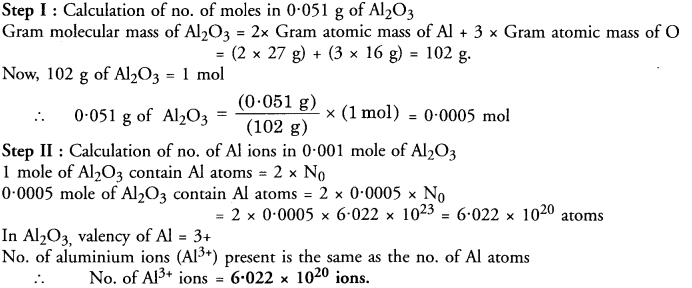
In-Text Questions
Question 1.
In a reaction, 5.3g of sodium carbonate reacted with 6 g of acetic acid. The products were 2.2 g of carbon dioxide, 0.9 g water and 8.2 g of sodium acetate. Show that these observations are in agreement with the law of conservation of mass. (CBSE 2012)
Answer:
The chemical reaction leading to products is :
sodium carbonate + acetic acid ———–> Sodium acetate + carbon dioxide + water.
Mass of reactants = (5.3 + 6.0) = 11.3 g
Mass of products = (8.2 + 2.2 + 0.9) = 11.3 g.
The reactants and products have same mass. This means that there was no loss of mass during the reaction. Therefore, the data is in agreement with law of conservation of mass.
Question 2.
Hydrogen and oxygen combine in the ratio of 1 : 8 by mass to form water. What mass of oxygen gas would be required to react with 3 g of hydrogen gas ?
Answer:
According to available data,
Mass of oxygen combining with 1 g of hydrogen = 8 g.

Question 3:
Which postulate of Dalton’s Atomic theory is the basis of law of conservation of mass ? (CBSE 2012)
Answer:
The law of conservation mass is based on the following postulate of Dalton’s Atomic theory.
“Atoms can neither be created nor destroyed during a physical change or a chemical reaction.”
Question 4.
Which postulate of Dalton’s Atomic theory can explain the law of definite proportions ?
Answer:
The law of definite proportions is based on the following postulate of Dalton’s Atomic theory.
“All atoms of a particular element are identical in every respect. This means that they have same mass, same size and also same chemical properties.”
Question 5.
Define atomic mass unit.
Answer:
Atomic mass unit may be defined as :
The mass of one-twelfth (1/12) of the mass of one atom of carbon taken as 12 u. It is represented as 1 u (unified mass).
Question 6.
Why is not possible to see an atom with naked eye ?
Answer:
It is not possible to see an atom with naked eye because of its extremely small size. For example, the radius of an atom of hydrogen is of the order of 10-10 m. Actually an atom is regarded as a microscopic particle. These microscopic particles cannot be seen with naked eye.
Question 7.
Write down the formulae of :
(i) sodium oxide
(ii) aluminium chloride
(iii) sodium sulphide
(iv) magnesium hydroxide.
Answer:
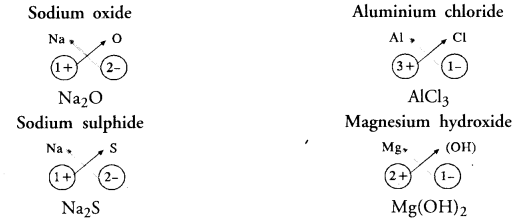
Question 8.
Write the names of the compounds represented by the following formulae :
(i) Al2(SO4)3
(ii) CaCl2
(Hi) K2SO4
(iv) KNO3
(v) CaCO3.
Answer:
(i) Aluminium sulphate
(ii) Calcium chloride
(iii) Potassium sulphate
(iv) Potassium nitrate
(v) Calcium carbonate
Question 9.
What is meant by the term chemical formula ?
Answer:
Molecule represents a group of two or more atoms (same or different) chemically bonded to each other and held tightly by strong attractive forces. Molecules are represented in terms of symbols of constituting atoms and it is known as chemical formula.
Question 10.
How many atoms are present in
(i) H2S molecule
(ii) PO43- ion ?
Answer:
(i) Three
(ii) Five.
Question 11.
Calculate the molecular masses of :
(i) H2
(ii) O2
(iii) Cl2
(iv) CO2
(v) CH4
(vi) C2H6
(vii) C2H4
(viii) NH3
(ix) CH3OH.
Answer:
(i) Hydrogen (H2)
Molecular mass of H2 = 2 x Atomic mass of H = (2 x 1 u) = 2 u.
(ii) Oxygen (O2)
Molecular mass of O2 = 2 x Atomic mass of O = (2 x 16 u) = 32 u.
(iii) Chlorine (CI2)
Molecular mass of Cl2 = 2 x Atomic mass of Cl = (2 x 35’5 u) = 71 u.
(iv) Carbon dioxide (CO2)
Molecular mass of CO2 = (1 x Atomic mass of C) + (2 x Atomic mass of O)
= (1 x 12 u) + (2 x 16 u) = 12 u + 32 u = 44 u.
(v) Methane (CH4)
Molecular mass of CH4 = ( 1 x Atomic mass of C) + (4 x Atomic mass of H)
= ( 1 x 12 u) + (4 x 1 u) = 16 u.
(vi) Ethane (C2H6)
Molecular mass of C2H6 = (2 x Atomic mass of C) + (6 x Atomic mass of H)
= (2 x 12 u) + (6 x 1 u) = 30 u.
(vii) Ethylene (C2H4)
Molecular mass of C2H4 =(2 x Atomic mass of C) + (4 x Atomic mass of H)
= (2 x 12 u) + (4 x 1 u) = 28 u.
(viii) Ammonia (NH3)
Molecular mass of NH3 = (1 x Atomic mass ofN) + (3 x Atomic mass of H)
= (1 x 14 u) + ( 3 x 1 u) = 17 u.
(ix) Methyl alcohol (CH3OH)
Molecular mass of CH3OH = (1 x Atomic mass of C) + (4 x Atomic mass of H)
+ (1 x Atomic mass of O)
= (1 x 12 u) + (4 x 1 u) + (1 x 16 u) = 32 u.
Question 12.
Calculate the formula unit mass of :
(i) ZnO
(ii) Na2O
(iii) K2CO3.
Given : Atomic masses of Zn = 65 u, Na = 23 u, K = 39 u, C = 12 u and O = 16 u.
Answer:
(i) Formula unit mass of ZnO (Zinc oxide)
= (1 x Atomic mass of Zn) +(1 x Atomic mass of O)
= (1 x 65 u) + (1 x 16 u) = 81 u.
(ii) Formula unit mass of Na2O (Sodium oxide)
= (2 x Atomic mass of Na) + (1 x Atomic mass of O)
= (2 x 23 u) + (1 x 16 u) = 62 u.
(iii) Formula unit mass of K2CO3 (Potassium carbonate).
= (2 x Atomic mass of K) + (1 x Atomic mass of C) + (3 x Atomic mass of O)
= (2 x 39 u) + (1 x 12 u) + (3 x 16 u) = 138 u
Question 13.
Calculate the number of moles of the following :
(i) 52 g of He
(ii) 12.044 x 1023 atoms of He.
Answer:


Question 14.
Calculate the number of particles in each of the following :
(i) 46 g of sodium atoms
(ii) 8 g of oxygen (O2)
(iii) 0.1 mole of carbon atoms.
Answer:
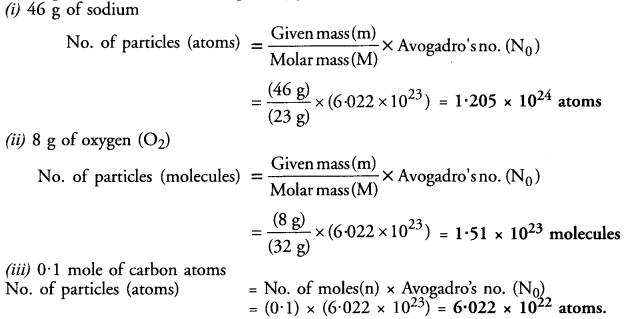
Question 15.
If one mole of carbon weighs 12 grams, what is the mass (in gram) of one atom of carbon ?
Answer:

Question 16.
Which has more number of atoms ?
(a) 100 grams of sodium
(b) 100 grams of iron
(Given : atomic mass of Na = 23 u ; Fe = 56 u)
Answer:
